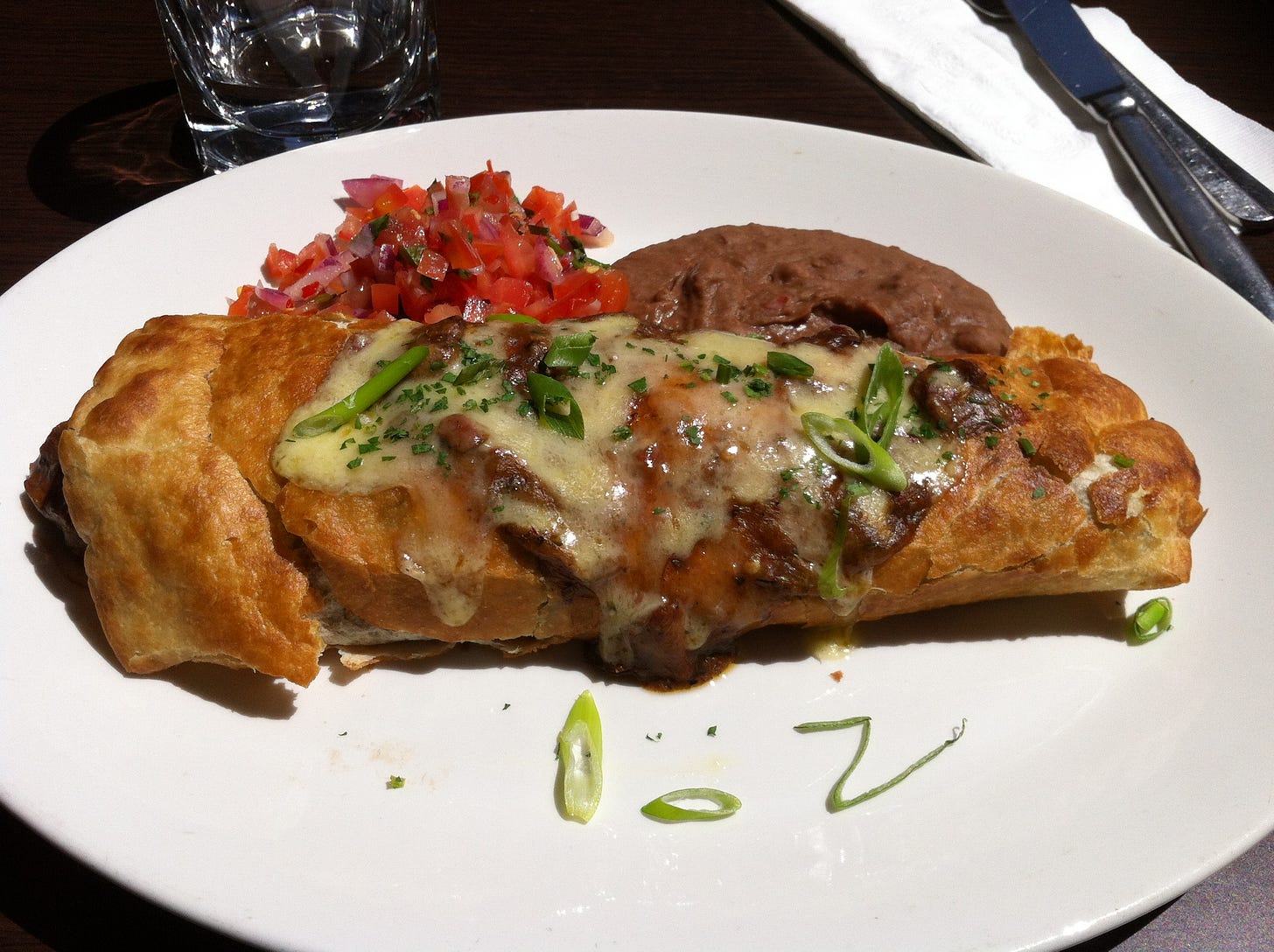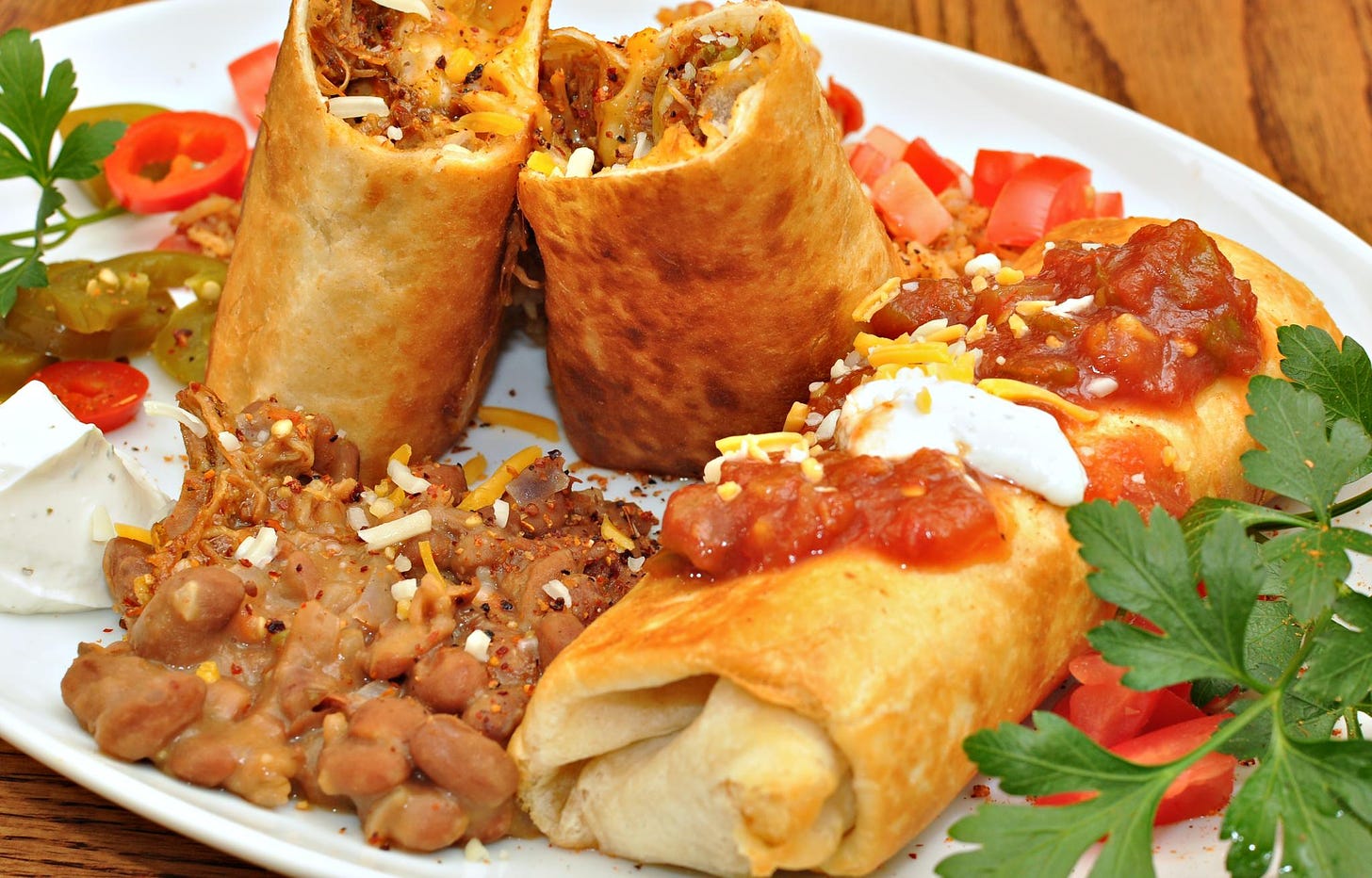The Long and Complex Origin Story of the Chimichanga
Everyone wants credit for this Mexican contribution to American cuisine — plus a recipe
As the burrito made its way from the kitchen tables of Cuidad Juarez to the diners of El Paso, Texas, a Mexican food phenomenon was born in the States. Americans were like “what?!?! Mexicans just south of the border have been eating food this good all along?” Yes, comrade. They have. And they had many more secrets to share. The state of Arizona figures big into the legend of the chimichanga, which, stated simply, is a burrito that’s been deep fried — usually served with cheese, sour cream, guacamole, and salsa. It sounds simple, but it’s taste is comforting, salty, crispy — the ultimate dish for someone craving some warmth and comfort in the coldness of winter, or needing something fresh and filling for a summer afternoon. Perfect with a margarita or a cold beer, it’s something most could eat every day. But the origin of the chimichanga is far from certain.
By some accounts, it originated in Mexico, but in others, it was created by accident in Arizona. Given the variant chivichanga — the term often employed in Mexico — one origin story said that immigrants to the United States brought the dish with them, mainly from the Mexican state of Sonora into Arizona. The words chimi and changa come from two Mexican Spanish terms: chamuscado — the past participle of the verb chamuscar — which means seared or singed, and changa, related to chinga — the third-person present tense form of the vulgar verb chingar — a rude expression for having sex — basically the equivalent verb form of the F word in English.
One popular theory puts the invention of the chimichanga well north of the border. It says that Woody Johnson — founder of Macayo’s Mexican Kitchen — invented the chimichanga in 1946 when he put some burritos into a deep fryer as an experiment at his original restaurant Woody’s El Nido, in Phoenix. These fried burritos became so popular that by 1952 — when Woody’s El Nido became Macayo’s — the chimichanga was one of the restaurant’s main menu items. Johnson opened Macayo’s in 1952.
Although no official records indicate when the dish first appeared, retired University of Arizona folklorist Jim Griffith recalls seeing chimichangas at the Yaqui Old Pascua Village in Tucson in the mid-1950s. George Jacob — owner of Club 21 in Tucson — recalls serving an Easterner a plain burro — the meat-wrapped-in-flour-tortilla assemblage that’s usually dubbed a burrito outside Arizona. The customer thought the burro looked raw and unappealing, so Jacob put some shortening on it and browned it on the grill. It sold well so they kept it on the menu. A few years later, a Mexican-born customer ordered a fried burro and called it que chango, which roughly translates to whimsical bow. The story goes that by 1954, Jacob’s fried burro had morphed into chimichanga and earned a regular spot on his menu. But does this make Jacob the chimichanga’s founding father?
Not according to Carlotta Flores, owner of Tucson’s El Charro Cafe. Family legend says Flores’s great-aunt, Monica Flin, who started the restaurant in 1922, cussed in the kitchen when a burro flipped into the deep fryer. As she was knee-deep in a gaggle of nieces and nephews, she changed the swear word to chimichanga — the Spanish equivalent of thingamajig. Today Flores serves some 10,000 chimichangas a week at her two restaurant locations. She has expanded the chimichanga section of her menu to include both a vegetarian version and a version called the USA Today — rolled and fried, it’s the size of a folded newspaper.
Frank Davis Jr., a third-generation Tucson restaurateur whose family started La Fuente in 1960, theorizes that geography influenced the development of the chimichanga. He thinks it got started along the border, in Sonora, Mexico because Sonora is a wheat capital of Mexico, and that’s where they first started making the large, 16- to 18-inch flour tortillas that are used for chimichangas. Jim Griffith, a folklorist at the University of Arizona’s Southwest Center, agrees with Davis on the chimi’s Sonoran origins. He thinks the dish probably developed somewhere in southern Arizona or northern Sonora where not only wheat but beef is grown. His first encounter with a chimichanga was during a mid-1950s Easter celebration at a Yaqui Indian village on the outskirts of Tucson, but he’s sure they were around for a long time before that. Whatever the place and year of its birth, the chimichanga has spread in popularity.
These days, you’re almost as likely to find it on menus in Seattle as in Tucson and in varieties that the original chimichanga makers wouldn’t have dreamed of. There seems to be only one thing about chimichangas that everyone seems to agree upon — they delicious and addicting.
Chimichangas al Charro
Note: At El Charro Cafe, Carlotta Flores makes chimichangas with giant 16- or 18-inch flour tortillas renowned in the Sonoran region. But 12- to 14-inch tortillas make impressive chimis too. Serves six.
Ingredients:
Six flour tortillas — as big as you can find
Carnitas filling (recipe below)
Enough oil of your choice for deep frying
Two avocados
Shredded lettuce (iceberg or romaine) or cabbage
Shredded cheese — I prefer cheddar or Monterey Jack.
Sour cream
Tomato based salsa or pico de gallo
Limes
Cilantro
Method:
Lay one tortilla flat. Fold 1/3 up over center. Spoon carnitas filling across the doubled portion, leaving a 2-inch border at each end. Roll tortilla once, fold in ends, then roll snugly to enclose filling. Repeat to fill remaining tortillas. (It’s basically like making a burrito except only the meat is inside.)
Once your oil is hot enough, lower 1–2 chimichangas at a time into the hot oil, careful to avoid crowding the pan. Fry until golden on all sides, turning occasionally, 6 to 8 minutes total per chimichanga.
Transfer cooked chimis to a paper towel lined plate or baking sheet until you’ve finished this process. Line a platter or plates with the lettuce, then plate the chimichangas over that.
Sprinkle the chimis with cheese and serve with salsa, sour cream, avocado slices, salsa, and lime slices. A little cilantro doesn’t hurt either. The carnitas filling (should be prepared before)
Carnitas filling
Note: This is the most time consuming part of the process, so most home cooks will make a large batch, use some, and then freeze the rest so they have it when they want to make chimichangas.
Cooking time: About 2–3 hours
Ingredients:
Pork loin or beef brisket (I prefer beef)
One large onion
2 carrots
10–12 garlic cloves
Salt
Honey (if you want — not at all required)
Method:
Put all the ingredients into a large Dutch oven or deep pan. Cover with water, just enough to cover the meat. Bring to a boil over high heat, then reduce heat and simmer, covered, until pork is tender when pierced — about two to three hours.
With a slotted spoon, transfer the meat to a platter when it’s cool enough to handle and pull into shreds with two forks or your fingers.





